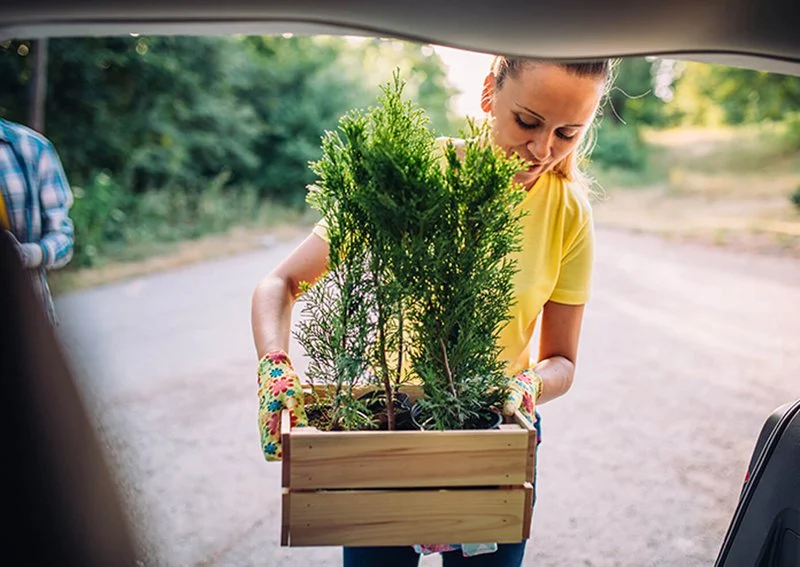
Without your houseplants, your new home won’t feel like home if you’re a plant parent. A professional moving company in your area might not handle live plants, therefore it’s important to learn how to pack plants carefully.
It will require some preparation to get the plants packed properly if you want your leafy offspring to go with you. Check out our plant packing advice to make sure your houseplants arrive undamaged.
Plant preparation is the first stage before the relocation. Since it takes time for plants to adjust, begin this process approximately three weeks before the move.
Repot plants from clay pots into identical-sized plastic pots three weeks before moving day. To use in your new house, wrap original pots in packing paper or bubble wrap.
Two weeks before the moving day, use sharp scissors to prune plants by cutting off dead leaves, branches, and blooms.
Before the day of relocation, three days in advance: Don’t overwater your plants; yet, do give them some water. When it’s warm outside, too much water might encourage the growth of fungi or cause the soil to freeze in the winter.

After getting your plants ready for transport, it’s time to gather packing materials to make the process of moving plants easier.
Gather the following relocation supplies:
Paper wrapper
Spray can
Bags made of plastic
Pap pads
How you pack your plants will guarantee that they reach their new location securely and undamaged, even on moving days.
To keep the dirt inside, start by filling your pot with dirt. Tie a plastic bag over the top and tape it at the plant’s base. By taking this precaution, you can stop soil from getting inside your car and creating a mess.
Read More: How to Pack Your Shoes for Moving?
Plants should be placed in moving boxes once the soil is firmly in place. Pick a container that will hold your plant with ease. Tiny plants fit all into one box, but large plans need their own.
When packing your plant cartons, adhere to the following guidelines:
Protect the base: To reduce the chance of the pot falling through, tape the box’s bottom.
Fill up the gaps: Use newspaper or packing paper to fill in the space surrounding the plant and the pot to keep it safe but breathable.
Hold it open: Particularly if you’re moving your plants in your car, just the plant base needs to fit inside the box. Sealing the boxes is not necessary.
Mark it: Whether you want to close the box or not, be careful to mark it as “fragile,” “up,” and “live plant” to ensure that it stays upright during the journey.
To protect your plants from frostbite during a winter move, cover the exposed sections of your plant with packing paper or newspaper to provide an extra layer of protection from the cold and wind. Avoid packing the trunk full of plants. Move your plants inside the car, where there is more ventilation.
In summer, if you are moving, keep your plants out of direct sunlight, give them plenty of water, and put some cool air conditioning in the car.
Never, regardless of the season, leave a plant in the car overnight if the temperature is dropping sharply. Bring your plants along to shield them from sudden temperature swings.

It’s time to move all of your plants into your moving truck now that you have done so carefully. Plants can be moved in your car or the cab of a moving truck, which is the most convenient and effective way to move them. A few things to consider when driving are listed below.
Your plants may suffer from extreme temperatures. However, plants will have access to sunshine when you move them in your car—not the trunk—and you may regulate the temperature to keep them at a comfortable level.
You can take care of the plants while you’re driving if you move them yourself. As you travel, keep an eye on them. Verify that the plants are constantly erect and see whether they require any watering, a temperature change, or more or less light.
Resetting your plants should be your priority as soon as you move into your new house. Make sure your plants are restored to their prior state when you move them into your new residence.
To get the greatest outcomes, abide by the following guidelines:
Unpack: Take out your plants from the car right away, and water them if necessary.
Location: Place plants back in the pots they came in and make sure they get the right kind of light.
Allow your plant some time to acclimate: If your plant has transplant shock, allow it a few days to recuperate.
Read More: How to Pack Your Books for Smooth Moving?
Take the same precautions you would with fewer plants while relocating larger ones.
To start, cover the soil to prevent spills during the move using a plastic bag or pieces of cardboard taped over it.
Sphagnum moss can also be added to the pot and covered with plastic wrap.
Taller plants can be lifted and placed on their side, or they can be gently moved. Once the plants become acclimated to their new location, you will wish to replant them.